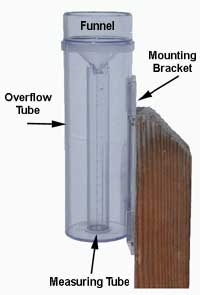How to install and maintain your equipment

-
NeRAIN volunteers use a large clear plastic gauge. When installing the rain gauge it is important to
consider its location. The gauge should be placed in an area that is protected from strong winds but
is not bothered by obstacles that could either block precipitation from reaching the gauge or cause
precipitation to splash towards it. For example, an ideal location would be a small open meadow surrounded
by forest, or an open back yard not too close to buildings or trees.
-
The gauge should be installed 2-5 feet above the ground mounted on the side of a single post.
The top of the rain gauge should extend several inches above the top of the mounting post.
The mounting post should have a rounded, pointed, or slanted top to avoid upward splash towards the rain gauge.
-
The rain gauge should be installed at a reasonable distance away from obstacles such as buildings and trees.
As a rule of thumb, if a tree is 40 feet tall (taller than a two story house) then the gauge should be placed a
minimum of 40 feet from it (80 feet away is better). This will help avoid potential blockage of the rain gauge.
It is not always possible to find a perfect location. When in doubt, do your best.
Installation
- Avoid large obstacles that could block precipitation.
- Avoid mounting the rain gauge where sprinklers or other sources of artificial precipitation can affect the data.
- Make sure the top of the rain gauge is level.
- Mount the rain gauge so that heavy rain could not splash into the gauge from any nearby surfaces.
- Mount the rain gauge in an area protected from strong wind, if possible.
Maintenance
- Clean the rain gauge periodically using a mild detergent and a soft bottlebrush.
- Do not let water freeze inside the gauge as it can cause the plastic to crack.
- Do not place the gauge in a microwave oven.


